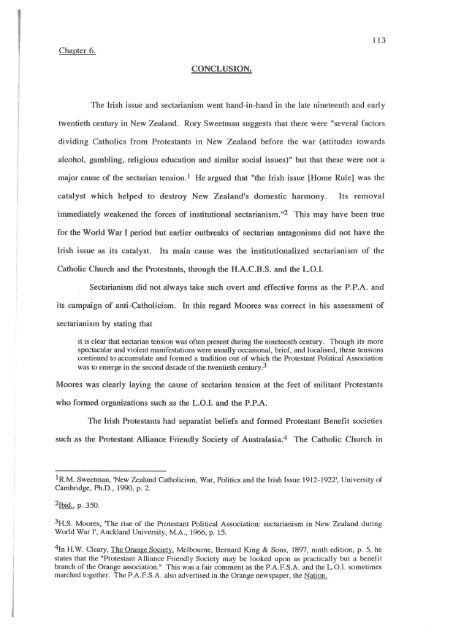TRANSPLANTED IRISH INSTITUTIONS - University of Canterbury
TRANSPLANTED IRISH INSTITUTIONS - University of Canterbury
TRANSPLANTED IRISH INSTITUTIONS - University of Canterbury
You also want an ePaper? Increase the reach of your titles
YUMPU automatically turns print PDFs into web optimized ePapers that Google loves.
Chapter 6.<br />
113<br />
CONCLUSION.<br />
The Irish issue and sectarianism went hand-in-hand in the late nineteenth and early<br />
twentieth century in New Zealand. Rory Sweetman suggests that there were "several factors<br />
dividing Catholics from Protestants in New Zealand before the war (attitudes towards<br />
alcohol, gambling, religious education and similar social issues)" but that these were not a<br />
major cause <strong>of</strong> the sectarian tension. I He argued that "the Irish issue [Home Rule] was the<br />
catalyst which helped to destroy New Zealand's domestic harmony.<br />
Its removal<br />
immediately weakened the forces <strong>of</strong> institutional sectarianism. "2 This may have been true<br />
for the World War I period but earlier outbreaks <strong>of</strong> sectarian antagonisms did not have the<br />
Irish issue as its catalyst.<br />
Its main cause was the institutionalized sectarianism <strong>of</strong> the<br />
Catholic Church and the Protestants, through the H.A.C.B.S. and the L.O.1.<br />
Sectarianism did not always take such overt and effective forms as the P.P.A. and<br />
its campaign <strong>of</strong> anti-Catholicism. In this regard Moores was correct in his assessment <strong>of</strong><br />
sectarianism by stating that<br />
it is clear that sectarian tension was <strong>of</strong>ten present during the nineteenth century. Though its more<br />
spectacular and violent manifestations were usually occasional, brief, and localised, these tensions<br />
continued to accumulate and fonned a tradition out <strong>of</strong> which the Protestant Political Association<br />
was to emerge in the second decade <strong>of</strong> the twentieth century.3<br />
Moores was clearly laying the cause <strong>of</strong> sectarian tension at the feet <strong>of</strong> militant Protestants<br />
who formed organizations such as the L.O.1. and the P.P.A.<br />
The Irish Protestants had separatist beliefs and formed Protestant Benefit societies<br />
such as the Protestant Alliance Friendly Society <strong>of</strong> Australasia. 4<br />
The Catholic Church in<br />
lR.M. Sweetman, 'New Zealand Catholicism, War, Politics and the Irish Issue 1912-1922', <strong>University</strong> <strong>of</strong><br />
Cambridge, Ph.D., 1990, p. 2.<br />
2Ibid., p. 350.<br />
3H.S. Moores, The rise <strong>of</strong> the Protestant Political Association: sectarianism in New Zealand during<br />
World War I', Auckland <strong>University</strong>, M.A., 1966, p. 15.<br />
4In H. W. Cleary, The Orange Society, Melbourne, Bernard King & Sons, 1897, ninth edition, p. 5, he<br />
states that the "Protestant Alliance Friendly Society may be looked upon as practically but a benefit<br />
branch <strong>of</strong> the Orange association." This was a fair comment as the P.A.F.S.A. and the L.O.1. sometimes<br />
marched together. The P.A.F.S.A. also advertised in the Orange newspaper, the Nation.
















